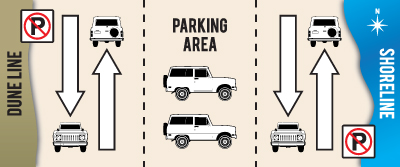
Get ready to go off-road and get sandy! Driving on Corolla’s 4×4 beaches is a fun way to enjoy the beach while seeing some of the amazing sights, such as the wild horses, during your vacation to Currituck’s Outer Banks. Like most of life’s worthwhile undertakings, driving on the beach is an experience that is greatly enhanced by a few simple preparations.
Before getting out on the sand, be sure to stop by the Corolla Visitor’s Center for the Guide to Beach Driving brochure. It contains valuable tips, information, rules, regulations and county ordinances to follow for your safety and the safety of others while driving on the beach.
As suggested by the name, 4×4 beach driving is really only accessible to registered, licensed and insured vehicles with 4×4 capability. DO NOT ATTEMPT to drive on the beach if your vehicle does not have 4WD.
Fill your tank before hitting the sand as there are no gas stations on the beach. Please note that no person shall drive a motor vehicle on the beach strand or foreshore with tires containing air pressure exceeding 20 pounds per square inch (p.s.i.)
Once driving, maintain a slow and steady pace, staying below 35 mph at all times. When nearing other drivers or pedestrians, slow to 15 mph and remember to use turn signals. These speed limits and safety regulations are not only for your safety but also for the other drivers, as well as the wild horses that are frequently spotted on the beach.
Do not stop or park at any point until you reach mile post 14 (about 1.5 miles down the shore). Park in the middle of the beach and keep any belongings (chairs, towels, etc.) with your vehicle in the center of the beach between the waterline and the dunes. Keep an eye on the tides, or you may soon find that the sea has claimed your favorite flip flops.
Vehicles must be parked in the area east of the dune line and west of the hard packed sand strip. The deeply rutted tracks next to the dunes are designated Fire, Emergency and Vehicular traffic lanes. Do not impede these lanes.

Watch out for pedestrians and wild horses! The sound of the surf, the sight of the sea and the scent of freedom on the open beach road can be distracting to drivers, but please remain vigilant. Children have a tendency to dart out in front of cars and the wild horses come and go as they please, sometimes at a full-fledged gallop. Many of the horses are dark in color and may be difficult to see at night, so exercise great caution.
At the end of the day, the entire beach becomes driving areas. Visitors are required to remove all equipment (beach chairs, poles, nets, etc.) and level all sand structures (sand castles, holes, etc.) to ensure the safety of those driving on the beach at night.
There are a few more rules and tips to know:
- Do not drink and drive (but we didn’t have to tell you that one did we?)
- You will be towed if you park or unload a vehicle at North Beach Access, or leave your vehicle overnight.
- No reckless driving (donuts, drifting, etc.) will be tolerated.
- No walking or driving on the dunes.
- DO NOT APPROACH OR FEED THE WILD HORSES. Aside from the danger of the horse injuring you, the lifestyle of the wild horses is extremely volatile. Enjoy their majesty from a distance of 50 feet. If you see an injured horse, please contact the Corolla Wild Horse fund at 252-453-8002.
- All pets must be leashed, and please remember to clean up after your furry friend.
- There are no restrooms on the beach, so please plan accordingly!
- There is absolutely no littering allowed.
- Glass, open burning and bonfires are prohibited.
- Overnight camping is not permitted.
- ATVs are not allowed on the beach, and neither are personal watercrafts (such as jet skis). Public ramps are located at Whalehead.
- Fireworks are prohibited on the beach, as they may ignite dry beach grass and wooden structures, and may cause further damage due to high winds.
